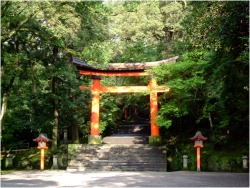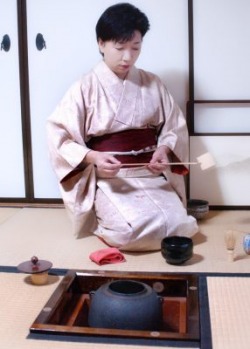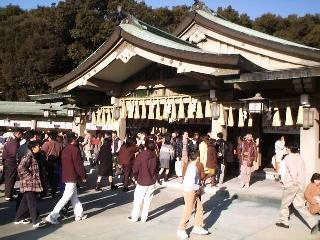Religion

Shintoism
Shintoism used to be the state religion of Japan. Although other religions are increasing in popularity, Shinto is still considered Japan's native religion. This religion is unique to the country, and involved the worship of spirits, or kami. These kami can be in the form of a spiritual guardian in a specific location, or even in the form of natural objects or processes. Examples of the major entities worshipped by the people are the Sun Goddess, Amiterasu, and Mount Fuji.
Shintoists do not follow any doctrines. The main principle of the followers is to live life simply in harmony with nature and people. There are, however, Four Affirmations that are inculcated in the Shinto spirit:
1) Tradition and the Family
The family is seen as the means by which traditions are practiced and preserved. The main traditions that are celebrated within the family are births and marriages.
2) Love of Nature
Natural objects are thought to contain spirits and are worshipped. Shintoists are encouraged to love and be as close to nature as possible as that will mean that they are closer to the spirits.
3) Physical Cleanliness
Shintoists are very particular about hygiene. They take baths, wash their hands and clean their mouths very frequently.
4) Matsuri
A Matsuri is a festival dedicated to the worship of the kami. Each Shinto shrine holds its own matsuri, and there are many of these festivals held in a year.
Traditions and Festivals
Traditional Tea Ceremony

The Japanese tea ceremony, also known as Chaji, is a formal event in which importance is placed in the experience and enjoyment of the rituals rather than the tea itself. The host will usually have practised the ceremony many times to ensure that every detail is perfect.
A three-course meal is usually served in a chaji, after which the guests will have an intermission in a garden as the host clears up the teahouse. After the utensils needed for the actual tea ceremony is prepared, the guests will be called back to the teahouse by the sound of a gong, if in the day, or a bell, if the ceremony is at night.
The tea served in this ceremony is thick- consistent with that of cream soup. The tea is served in a tea bowl, which is passed first to the main guest (appointed by the other guests for the purpose of the ceremony) who examines the bowl closely before drinking from it. The rim of the bowl where the guest has drunk from is then wiped before being passed to the next guest to drink from. There are usually four guests invited to the formal tea ceremony, although five should be the maximum number.
After each guest has drunk from the tea bowl, it is then passed back to the host, who rinses and cleans all the utensils. A discussion of the tea ceremony objects, presentation and other topics then takes place.
Thin tea is served after the ceremony to cleanse the palates of the guests and prepare them for their departure from the spiritual world of tea into the physical world. Each guest is given their own individual tea bowls to drink from. Smoking articles are also offered, though smoking seldom occurs in a tearoom.
At the end of the event, guests will usually express their gratitude and admiration for the tea and finesse of the host. As they leave, the host will usually stay behind in the teahouse and watch them from the door.
New Year's Day

The New Year is the most celebrated holiday in Japan. On this day, most shops will be closed, and the streets will be mainly deserted. Most Japanese will travel to other countries during the first few days of the New Year to escape the cold season. Those that stay behind often visit their shrines, which are the only places bustling with activity during that period, to pray for their families' good health and fortune. It is in their tradition to visit about 3 different Shinto shrines on this day. New Year's Day is also one of the rare occasions where the people dress up in their kimonos.
Christmas Day

Although the Christian population in Japan is insignificant, Christmas Day is a widely-celebrated occasion in the country. The emphasis in this festival is not in the religion itself, but in the ritual of exchanging gifts. Department stores will be decked out with Christmas decorations, although none of these can be found in Japanese houses. On this day, most Japanese would flock to western restaurants or food places, like KFC, as a symbolic way of keeping in line with Christmas traditions.
Shichi Go San

The Shichi Go San is a Japanese festival held in honour of three and five-year-old boys, as well as three and seven-year-old girls. On this day, the children are brought to a Shinto shrine in their first kimonos and their parents pray for their health and prosperity. In the past, it was considered an achievement for children to have lived up to these ages, due to the high infant mortality rate. Families would celebrate this achievement by giving the children gifts on this day, and this tradition has followed up to today.
Language

Japanese is the official language of Japan, therefore it is heavily related to Japanese culture and vice-versa. The Japanese language is written with a combination of three different scripts: modified Chinese characters, kanji, and two syllabic scripts made up of modified chinese characters, hiragana and katakana. Japanese vocabulary has been heavily influenced by loan words from other languages. A vast number of words were borrowed from Chinese, or created from Chinese models, over a period of at least 1500 years.
Hiragana and Katakana are phonetic representations of sounds, and each letter basically corresponds to one mora (a unit of sound). Kanji convey meanings as well as sounds. In Japaese script, all three types of letters are used together. Hiragana is used to write particles etc. Katakana is used to write foreign names and loan words.
The Japanese language is based on 5 vowels: a, i, u, e, o. All spoken sounds are derived from these five words. They are used alone or are attached to either a consonant or a consonant plus the semi-vowel. All of these sounds are of equal length when spoken. A long vowel is pronounced twice as long as the ordinary vowels. Whether a vowel sia long or not can change the meaning of the word. The Japanese language has pitch accent. Thus, some moras are pronounced high and others low. Questions are pronounced with a rising intonation. Other sentences are normally pronounced flat, but sometimes with a falling intonation. falling intonation can express feelings.
Some useful phrases in Japanese:
Hai - Yes
Ie - No
Ohayoo gozaimasu - Good morning
Konnichiwa - Good afternoon
Konbanwa - Good evening
Sayoonara - Good bye
Arigatoo gozaimasu - Thank you
Sumimasen - I'm sorry
Hajimemashite - How do you do?
Doozoyoroshiku onegaishimasu - Pleased to meet you.
Ichi - One
Ni - Two
San - Three
Shi - Four
Go - Five
Roku - Six
Shichi - Seven
Hachi - Eight
Kyu - Ni
Nichiyobi - Sunday
Getsuyobi - Monday
Kayobi - Tuesday
Suiyobi - Wednesday
Mokuyobi - Thursday
Kinyobi - Friday
Doyobi - Saturday
Kohii - Coffee
Kocha - Tea
Miruku - Milk
Jusu - Juice
Wain - Wine
Biiru - Beer
Kuko - Airport
Chikatetsu - Metro
